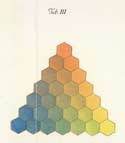Exhibits
Tobias Mayer's Color Algebra
Mayer's Criteria
- The triangle should include only body colors.
- All colors can be represented by the mixture of only three principal colors.
- Each color will have an unambiguous identification, through a three-part number.
- All the colors will be represented in a three-dimensional arrangement (or order).
- As experiment showed, the numbers of colors represented will correspond to the ability of the eye to distinguish similar colors from one another.
Using the Triangle
Every color is assigned a formula, based on the required quantity of red, yellow, and blue (for the "perfect" colors) or red, yellow, and blue plus black or white (for the dark and light colors respectively). Mayer wrote these numbers as coefficients, although he assures the reader there is no algebraic or logarithmic relationship among the colors. This is a shorthand method to indicate formula; in truth, each of these numbers should be written x/12. The superscript indicates the proportional quantity of each color. The sum of the coefficients in each compartment adds up to 12. Because the numbers are proportional to each other, the color r36b84y24 is the same as r3b7y2. A formula of r4b8 is the same as rb2. Web Link
2. To create a color, find it on the chart and note the formula. Combine the colors in the proportion indicated and you will have made the color you desired. In a similar manner, you might compare the color on objects, or on natural-history specimens, to the chart and determine the "number" of each of that object's colors. This information could then be used in drawings or other exchanges of information. Mayer used cinnabar, mountain blue (azurite), and King's yellow as his unmixed, unbroken colors (r12, b12, and y12 respectively). Red lead (minum), he found, had the formula of r8y4. It would be possible to use that mixture as a substitute for red lead, or should the occasion arise, to replace red lead with cinnabar by adjusting the amount of yellow in the other colors of the mixture.
3. Suppose you wish to find a color described as 2 parts cinnabar, 1 part ocher, 3 parts Prussian blue. The numerical equivalents for these colors are:
Cinnabar r12
Ocher r4y6b2
Prussian blue r2b10
Multiply the formula for each by its proportion in the desired color:
| r12 x 2 r24 |
r4y6b2 x 1 r4y6b2 |
r2b10 x 3 _ r6b30 |
and add the coefficients for each color—r34, y6, b32—and then divide those numbers by the number of parts (2 + 1 + 3 = 6): r5-2/3yb5-1/3.
Now, the fractional numbers for the blue and red indicate that each will fall into the "indistinguishable" area between colors, and it should be rounded up or down to the next closest number, giving a final formula for the color made of 2 parts cinnabar, 1 part ocher, and 3 parts Prussian blue: r6yb5
4. Or, suppose you have a formula r7y2b3 and you wish to find a way to prepare it with red lead and ocher and azurite.
Let Red lead (formula: r8y4) = x
Let Ocher (formula: r4y6b2) = y
Let azurite (formula: b12 ) = z
The resulting color equations are:
| For Red: | For Yellow: | For Blue: | |||
|---|---|---|---|---|---|
| 7 = | 8x + 4y x + y + z |
2 = | 4x + 6y x + y + z |
3 = | 2y + 12z x + y + z |
Or 0 = 3y - x + 7z 0 = 4y + 2x - 2z 0 = y + 3x - 9z
Adding these equations gives 8y + 4x - 4z. As it is impossible to add a negative amount of a color, this formula cannot be produced from the combination of red lead, ocher, and azurite.
^topSource: Tobias Mayer, "Treatise on the Relationship of Colors," in Tobias Mayer's "Opera Inedita": The First Translation of the Lichtenberg Edition of 1775, trans. Eric G. Forbes (New York, 1971), 81–91.

